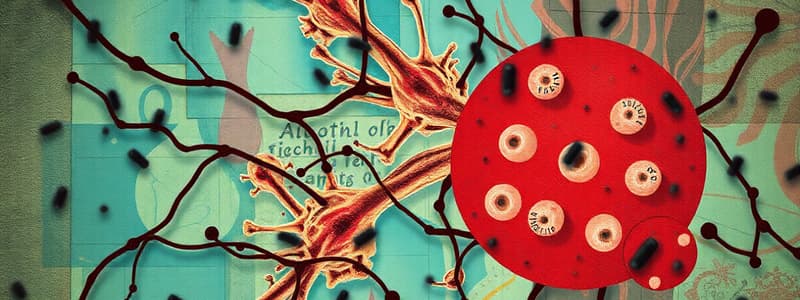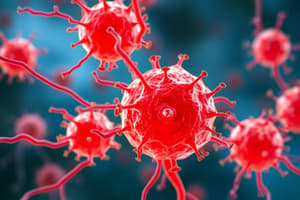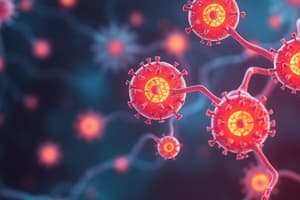Podcast
Questions and Answers
What is the main function of the lymph nodes?
What is the main function of the lymph nodes?
- Defense against microorganisms and tumor cells (correct)
- Storage of platelets
- Production of red blood cells
- Filtration of blood
What type of cells are predominantly found in lymph nodes?
What type of cells are predominantly found in lymph nodes?
- Neutrophils
- Plasma cells (correct)
- Basophils
- Eosinophils
Which region of a lymph node is characterized by a lack of lymphoid nodules?
Which region of a lymph node is characterized by a lack of lymphoid nodules?
- Medulla
- Subcapsular sinus
- Outer cortex
- Paracortex (correct)
Where do T lymphocytes mature after originating in the red bone marrow?
Where do T lymphocytes mature after originating in the red bone marrow?
Which structure ensures that lymph flow is unidirectional in lymph nodes?
Which structure ensures that lymph flow is unidirectional in lymph nodes?
The spleen plays a crucial role in the destruction of which type of cells?
The spleen plays a crucial role in the destruction of which type of cells?
What happens to the thymus after puberty?
What happens to the thymus after puberty?
Which cells are found in the cortical region of the thymus?
Which cells are found in the cortical region of the thymus?
What component of the spleen is responsible for filtering blood?
What component of the spleen is responsible for filtering blood?
What is located at the hilum of a lymph node?
What is located at the hilum of a lymph node?
What do Thymic Epithelial Cells (TECs) contribute to in the thymus?
What do Thymic Epithelial Cells (TECs) contribute to in the thymus?
Which of the following is NOT a major anatomical region of the lymph node?
Which of the following is NOT a major anatomical region of the lymph node?
What characterizes the staining appearance of the thymic cortex compared to the medulla?
What characterizes the staining appearance of the thymic cortex compared to the medulla?
What structures are unique to the thymic medulla?
What structures are unique to the thymic medulla?
What is the function of the connective tissue capsule in the thymus?
What is the function of the connective tissue capsule in the thymus?
What is the primary lymphoid organ responsible for the maturation of B lymphocytes?
What is the primary lymphoid organ responsible for the maturation of B lymphocytes?
What is the main function of mucosa-associated lymphoid tissue (MALT)?
What is the main function of mucosa-associated lymphoid tissue (MALT)?
Which of the following correctly identifies the types of tonsils present in the mucosa?
Which of the following correctly identifies the types of tonsils present in the mucosa?
Which type of epithelium covers the pharyngeal tonsil?
Which type of epithelium covers the pharyngeal tonsil?
Where are Peyer's patches predominantly located?
Where are Peyer's patches predominantly located?
What percentage of the body’s immune cells is found in MALT?
What percentage of the body’s immune cells is found in MALT?
What distinguishes lymph nodes from MALT in structure?
What distinguishes lymph nodes from MALT in structure?
Where in the body is the concentration of lymph nodes typically highest?
Where in the body is the concentration of lymph nodes typically highest?
What type of connective tissue is associated with MALT?
What type of connective tissue is associated with MALT?
Flashcards
Where do lymphocytes mature?
Where do lymphocytes mature?
Lymphocytes (T & B) are produced in the bone marrow. B cells mature in the bone marrow. T cells mature in the thymus. This maturation occurs in the central or primary lymphoid organs.
What is the Thymus?
What is the Thymus?
The thymus is a bilobed organ located in the mediastinum. It's crucial for T cell production.
How does the thymus change with age?
How does the thymus change with age?
After birth, the thymus actively produces T cells until puberty. Then, it shrinks and becomes less active, replaced by fat.
What are thymic epithelial cells (TECs) and where are they found?
What are thymic epithelial cells (TECs) and where are they found?
Signup and view all the flashcards
Describe the structure of the thymus.
Describe the structure of the thymus.
Signup and view all the flashcards
What's the difference between the cortex and medulla of the thymus?
What's the difference between the cortex and medulla of the thymus?
Signup and view all the flashcards
What are Hassall corpuscles?
What are Hassall corpuscles?
Signup and view all the flashcards
What is the role of TECs in T cell development?
What is the role of TECs in T cell development?
Signup and view all the flashcards
What is MALT (Mucosa-Associated Lymphoid Tissue)?
What is MALT (Mucosa-Associated Lymphoid Tissue)?
Signup and view all the flashcards
What are tonsils?
What are tonsils?
Signup and view all the flashcards
What are Peyer's patches?
What are Peyer's patches?
Signup and view all the flashcards
What is the appendix?
What is the appendix?
Signup and view all the flashcards
What are lymph nodes?
What are lymph nodes?
Signup and view all the flashcards
What is lymph?
What is lymph?
Signup and view all the flashcards
What are lymphatic vessels?
What are lymphatic vessels?
Signup and view all the flashcards
What is lymph filtration?
What is lymph filtration?
Signup and view all the flashcards
What are afferent and efferent lymphatics?
What are afferent and efferent lymphatics?
Signup and view all the flashcards
What is the cortex of a lymph node?
What is the cortex of a lymph node?
Signup and view all the flashcards
What is the paracortex of a lymph node?
What is the paracortex of a lymph node?
Signup and view all the flashcards
What is the medulla of a lymph node?
What is the medulla of a lymph node?
Signup and view all the flashcards
What is the spleen and what is its main function?
What is the spleen and what is its main function?
Signup and view all the flashcards
What is the splenic pulp?
What is the splenic pulp?
Signup and view all the flashcards
What are trabeculae in the spleen?
What are trabeculae in the spleen?
Signup and view all the flashcards
Study Notes
Lymphatic System Histology
- All lymphocytes (T & B cells) originate in red bone marrow, but mature in primary lymphoid organs.
- B cells remain and mature in the bone marrow.
- T cells migrate from the bone marrow to the thymus.
- After maturation, B and T cells circulate to secondary lymphoid organs (e.g., MALT, lymph nodes, spleen).
- Stem cells in the red bone marrow differentiate into undifferentiated lymphocytes.
- Some undifferentiated lymphocytes are processed in the thymus to become T cells.
- Other undifferentiated lymphocytes mature into B cells, possibly in the bone marrow.
- T and B cells travel through the bloodstream to lymphoid organs.
Thymus
- The thymus is a primary lymphoid organ in the mediastinum.
- It's bilobed and highly active until puberty, after which it shrinks.
- The thymus has connective tissue septa that divide it into lobules.
- The cortex, stained darkly basophilic, has a high density of lymphocytes.
- The medulla, stained lightly, has fewer lymphocytes and Hassall corpuscles (aggregates of thymic epithelial cells).
- Thymic epithelial cells (TECs) are involved in T cell development.
- TECs are involved in the maturation of T cells.
Mucosa-Associated Lymphoid Tissue (MALT)
- MALT is widespread in mucosal linings of digestive, respiratory, and genitourinary tracts.
- MALT protects against pathogens with collections of lymphocytes, plasma cells, and lymphoid nodules.
- MALT includes large aggregates of lymphoid tissue like tonsils, Peyer's patches in the ileum, and the appendix.
- MALT may contain up to 70% of the body's immune cells.
- Tonsils are lymphoid masses located in the oral cavity and nasopharynx.
- Peyer's patches are lymphoid tissue aggregations in the ileum.
- The appendix is a lymphoid-rich structure that projects from the cecum.
Lymph Nodes
- Lymph nodes are bean-shaped structures found throughout the body.
- Lymph nodes act as filters for lymph, preventing the spread of microorganisms and tumor cells.
- They contain lymphocytes, plasma cells, and macrophages.
- Lymph nodes have a capsule, cortex, medulla, and paracortex.
- Lymph enters through afferent lymphatics and exits through efferent lymphatics.
Spleen
- The spleen is a large accumulation of lymphoid tissue in the body, also a vital filter for blood.
- The spleen is involved in filtering blood and removing old red blood cells.
- It contains white pulp (lymphoid nodules and periarterial lymphoid sheaths), and red pulp (sinusoids and cords).
- The splenic artery branches penetrate the hilum (concave region) to reach the pulp
- The white pulp contains lymphocytes and is involved in immune responses to blood-borne antigens.
- The red pulp filters blood and removes old red blood cells.
Studying That Suits You
Use AI to generate personalized quizzes and flashcards to suit your learning preferences.




